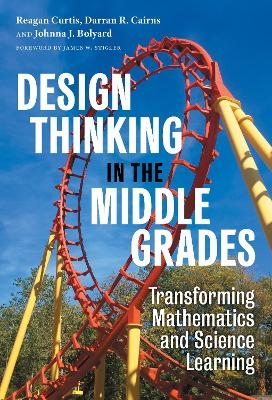
Design Thinking in the Middle Grades
Teachers' College Press (Verlag)
978-0-8077-6781-8 (ISBN)
- Titel z.Zt. nicht lieferbar
- Versandkostenfrei
- Auch auf Rechnung
- Artikel merken
Too often, mathematics and science are taught in isolation from each other and from meaningful problems that matter to students. This book draws on the authors' experiences with teacher colleagues, including time spent in their classrooms co-developing and refining lessons. The core of their approach is to encourage learners to pursue solutions to everyday challenges through design-based learning cycles. Students use mathematical modeling to describe or summarize a phenomenon, predict which potential solutions may be successful, and/or to test actual performance against predictions. The authors emphasize connecting grade-appropriate science and math content standards and integrating literacy with evidence-based argument through design briefs and presentations. Teachers will learn how to support productive struggle and structure group learning that promotes equity, while teaching in the classroom or virtually as needed.
The middle grades are a pivotal time to engage the next generation so that they are prepared to solve tomorrow's challenges. Classroom teachers, pre-service educators, and faculty in teacher education programs can use Design Thinking in the Middle Grades as a foundational text for math, science, and integrated STEM teaching.
Reagan Curtis is a Chester E. and Helen B. Derrick Endowed Professor of educational psychology in the School of Education and founding director of the Program Evaluation and Research Center at West Virginia University. Darran R. Cairns is faculty in the School of Science and Engineering at the University of Missouri–Kansas City. Johnna J. Bolyard is an associate professor of mathematics education in the School of Education at West Virginia University.
Contents
Foreword
Introduction
Acknowledgements
Part I: Understanding the Approach
1. Thinking Differently About Teaching and Learning
What It Looks Like in a Real Classroom
Why This Book?
2. Engineering Design, Mathematics, Science, and Literacy
A Visual Model of Our Approach
The Design Process: Dynamic, Iterative Waves of Divergent and Convergent Thinking
Integrating Mathematical Modeling, Scientific Challenges, and Literacy Practices
3. Affordances and Supports
Supporting Productive Struggle by Learners
Promoting Equity in the Classroom
Complex Instruction
Group Worthy Tasks
Status
4. Why Do We Think This Works?
Evidence-Based Teaching Practices
Evidence Base for Core Components of Our Approach
Evidence Base for Bringing It All Together
5. Personifying Best Practices
(Re)Designing Industrial Farming in Your State
Connecting Theory to Practice
Part II: Making It Real
6. Design and Mathematical Modeling From Artifacts to Processes
Affordances for Systems-Level Learning across the Artifact-To-Process Continuum
Returning to the Grocery Store
7. How Constraints and Criteria Affect Design and Mathematical Modeling
How Many Marbles Can You Fit in a Piece of Aluminum Foil Before It Sinks?
Keeping a Cold Drink Cold for Longer (Co-Constructing Constraints)
8. Scaffolding Student Learning in Design and Mathematical Modeling
Productive Struggle in Design-Based Learning
Scaffolding Productive Struggle
Strategically Using Formative Assessment Data
Giving Students Voice in Design Constraints, Criteria, and Methods of Assessment
9. Design and Mathematical Modeling Across Content Areas and Grade Levels
Gingerbread House Lesson (6th Grade Mathematics Class)
Predator/Prey Lesson (8th Grade Science Class)
Skater Ramp Lesson (7th Grade Mathematics and Science Class)
Adapting Design-Based Learning Activities to Your Students
10. Design and Mathematical Modeling Across Instructional Modalities
Taking Design-Based Learning Online
Examples of Design-Based Learning at a Distance
Connecting Examples to Core Components, Affordances, and Supports
Part III: Making It Your Own
11. Linking Integrative Series of Design and Mathematical Modeling Activities
Problem-Based, Design-Based, and Project-Based Integration
Energy and the Environment Thematic Unit
Pulling It All Together
12: Address Any Content Standard and "Fix" Textbook Problems
Starting From Standards
Starting From Existing Activities or Problems
(Re)Designing Effective Teaching Practices
Conclusion: The Wicked Problem of Education for All
References
Index
About the Authors
| Erscheinungsdatum | 03.04.2023 |
|---|---|
| Verlagsort | New York |
| Sprache | englisch |
| Maße | 152 x 229 mm |
| Gewicht | 272 g |
| Themenwelt | Schulbuch / Wörterbuch |
| Sozialwissenschaften ► Pädagogik ► Schulpädagogik / Grundschule | |
| Sozialwissenschaften ► Pädagogik ► Schulpädagogik / Sekundarstufe I+II | |
| ISBN-10 | 0-8077-6781-6 / 0807767816 |
| ISBN-13 | 978-0-8077-6781-8 / 9780807767818 |
| Zustand | Neuware |
| Informationen gemäß Produktsicherheitsverordnung (GPSR) | |
| Haben Sie eine Frage zum Produkt? |
aus dem Bereich


